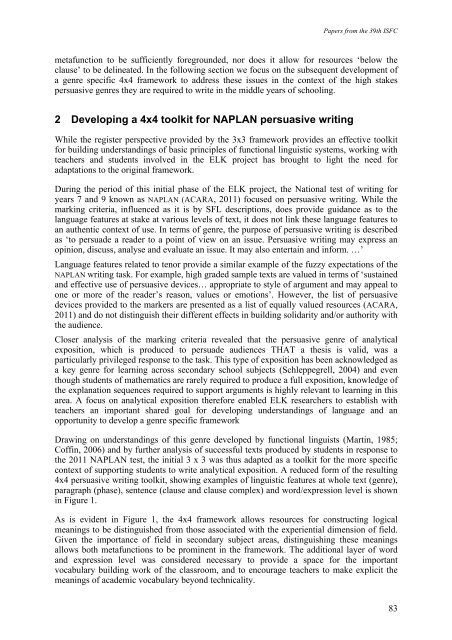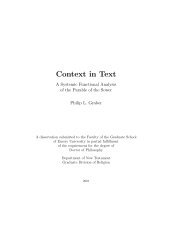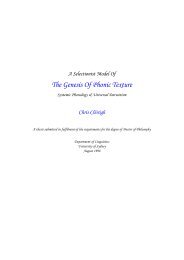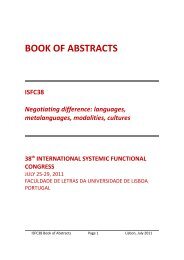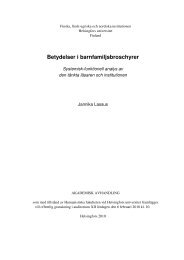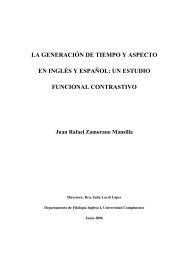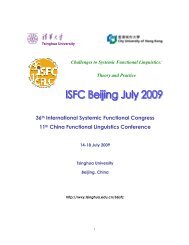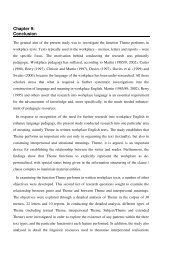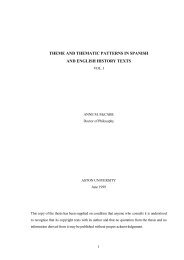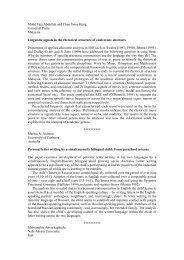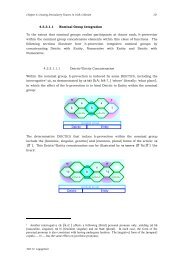the ISFC39 Proceedings - International Systemic-Functional ...
the ISFC39 Proceedings - International Systemic-Functional ...
the ISFC39 Proceedings - International Systemic-Functional ...
You also want an ePaper? Increase the reach of your titles
YUMPU automatically turns print PDFs into web optimized ePapers that Google loves.
Papers from <strong>the</strong> 39th ISFCmetafunction to be sufficiently foregrounded, nor does it allow for resources ‘below <strong>the</strong>clause’ to be delineated. In <strong>the</strong> following section we focus on <strong>the</strong> subsequent development ofa genre specific 4x4 framework to address <strong>the</strong>se issues in <strong>the</strong> context of <strong>the</strong> high stakespersuasive genres <strong>the</strong>y are required to write in <strong>the</strong> middle years of schooling.2 Developing a 4x4 toolkit for NAPLAN persuasive writingWhile <strong>the</strong> register perspective provided by <strong>the</strong> 3x3 framework provides an effective toolkitfor building understandings of basic principles of functional linguistic systems, working withteachers and students involved in <strong>the</strong> ELK project has brought to light <strong>the</strong> need foradaptations to <strong>the</strong> original framework.During <strong>the</strong> period of this initial phase of <strong>the</strong> ELK project, <strong>the</strong> National test of writing foryears 7 and 9 known as NAPLAN (ACARA, 2011) focused on persuasive writing. While <strong>the</strong>marking criteria, influenced as it is by SFL descriptions, does provide guidance as to <strong>the</strong>language features at stake at various levels of text, it does not link <strong>the</strong>se language features toan au<strong>the</strong>ntic context of use. In terms of genre, <strong>the</strong> purpose of persuasive writing is describedas ‘to persuade a reader to a point of view on an issue. Persuasive writing may express anopinion, discuss, analyse and evaluate an issue. It may also entertain and inform. …’Language features related to tenor provide a similar example of <strong>the</strong> fuzzy expectations of <strong>the</strong>NAPLAN writing task. For example, high graded sample texts are valued in terms of ‘sustainedand effective use of persuasive devices… appropriate to style of argument and may appeal toone or more of <strong>the</strong> reader’s reason, values or emotions’. However, <strong>the</strong> list of persuasivedevices provided to <strong>the</strong> markers are presented as a list of equally valued resources (ACARA,2011) and do not distinguish <strong>the</strong>ir different effects in building solidarity and/or authority with<strong>the</strong> audience.Closer analysis of <strong>the</strong> marking criteria revealed that <strong>the</strong> persuasive genre of analyticalexposition, which is produced to persuade audiences THAT a <strong>the</strong>sis is valid, was aparticularly privileged response to <strong>the</strong> task. This type of exposition has been acknowledged asa key genre for learning across secondary school subjects (Schleppegrell, 2004) and eventhough students of ma<strong>the</strong>matics are rarely required to produce a full exposition, knowledge of<strong>the</strong> explanation sequences required to support arguments is highly relevant to learning in thisarea. A focus on analytical exposition <strong>the</strong>refore enabled ELK researchers to establish withteachers an important shared goal for developing understandings of language and anopportunity to develop a genre specific frameworkDrawing on understandings of this genre developed by functional linguists (Martin, 1985;Coffin, 2006) and by fur<strong>the</strong>r analysis of successful texts produced by students in response to<strong>the</strong> 2011 NAPLAN test, <strong>the</strong> initial 3 x 3 was thus adapted as a toolkit for <strong>the</strong> more specificcontext of supporting students to write analytical exposition. A reduced form of <strong>the</strong> resulting4x4 persuasive writing toolkit, showing examples of linguistic features at whole text (genre),paragraph (phase), sentence (clause and clause complex) and word/expression level is shownin Figure 1.As is evident in Figure 1, <strong>the</strong> 4x4 framework allows resources for constructing logicalmeanings to be distinguished from those associated with <strong>the</strong> experiential dimension of field.Given <strong>the</strong> importance of field in secondary subject areas, distinguishing <strong>the</strong>se meaningsallows both metafunctions to be prominent in <strong>the</strong> framework. The additional layer of wordand expression level was considered necessary to provide a space for <strong>the</strong> importantvocabulary building work of <strong>the</strong> classroom, and to encourage teachers to make explicit <strong>the</strong>meanings of academic vocabulary beyond technicality.83


